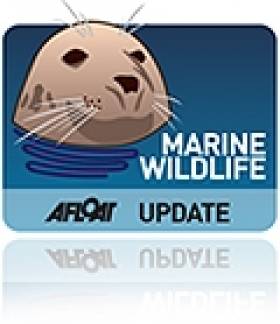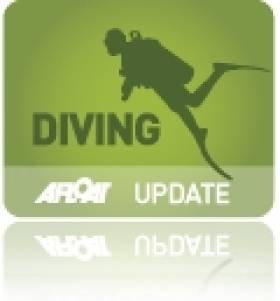Displaying items by tag: RTE
Listen to RTE Seascapes Maritime Radio on Afloat.ie
" You're very welcome aboard SEASCAPES the maritime programme on RTE Radio 1 with Marcus Connaughton
.......This podcast is available to you courtesy of RTE Radio 1 and Afloat.ie."
This week we feature the Irish Sailing Association Annual Awards in the Royal College of Surgeons in Ireland on St Stephens Green in Dublin we heard last week from President David Lovegrove and CEO Harry Hermon , so we’ll be talking to John Treacy of Sport Ireland; veteran Sailing journalist William N Nixon on his Lifetime Achievement Award; AFLOAT editor – David O’ Brien; AFLOAT SAILOR OF THE YEAR – Liam Shanahan of The National Yacht Club; Paralympians John Twomey and Ian Costelloe on how schools can become involved in their campaign ; writer and broadcaster Norman Freeman author of The Lure of Far Away Places recalls the Haj and pilgrims making the voyage to Mecca ; ............... first on Seascapes this week to James Horan, Commodore of the Royal Irish Yacht Club whom we met here on Seascapes a few weeks ago, the RIYC were recognised as the Mitsubishi Club of the Year at the ISA Awards in the Royal College of Surgeons in Ireland.
Click above to hear the full Seascapes programme.
Tributes Paid to Marine Journalist Derek Davis
#derekdavis – Marine minister Simon Coveney TD has led tributes to marine journalist Derek Davis (67) who died today. The former broadcaster and RTÉ TV presenter and former Afloat fishing correspondent was born in Co Down and began his media career as a news journalist, working with the American network ABC and BBC Northern Ireland before moving to the newsroom in RTÉ.
'Derek was a big personality, a passionate and talented communicator on both food and marine issues. His love for the sea was so evident whenever I met him. Derek was a much loved figure in so many Irish homes for the connections he created over a lifetime of broadcasting', Mr. Coveney said. 'He will be missed by so many. I'd like to offer my condolences to his family and many friends.' he added.
And tributes paid to broadcaster Derek Davis who died today. Join @boucherhayes from 4.30 http://t.co/wDHBvgfmPk pic.twitter.com/t5tCdU1hru
— Drivetime RTE (@drivetimerte) May 13, 2015
[UPDATED] Former RTÉ radio & TV host Derek Davis has died - http://t.co/iSkfH7Tf1Q #RIP #RadioNews pic.twitter.com/lDf0GbY5Eh
— RadioToday (@RadioTodayIE) May 13, 2015
Check out a gallery of the late broadcaster and writer Derek Davis whose died earlier today http://t.co/OGftaLtN14 pic.twitter.com/aedNpTUewk
— RTÉ One (@RTEOne) May 13, 2015
Seascapes On RTE Radio 1 Has Much To Celebrate After 25 Years
#seascapes – The maritime community in Ireland is a mystery to the vast majority of the rest of the population. Admittedly anyone Irish will sing enthusiastically about how good it is to be entirely surrounded by water. But for most folk among a people who like to think that they're basically rural even if the reality is they're increasingly urban, the sea is seen as no more than a useful barrier, while the coast is only briefly a fun place at the very height of a good summer.
The sea and the coastal interface are not seen as an exciting world in itself, a unique environment which deserves to be explored, enjoyed and utilised in practical and often beneficial ways. On the contrary, the popular view of the plain people of Ireland is that the less they know about the sea, the better. And the unspoken corollary of this is that anyone who seeks to go to sea for recreation is at best a bit odd, maybe even a misfit ashore, while those who work on the sea only do so because they couldn't get a job on land.
Here at Afloat.ie, in its various manifestations over the past 52 years, we've been trying to spread mutual understanding and useful information among the many and varied strands of those who go afloat for sport and recreation in Ireland and beyond. We know this is largely a matter of preaching to the converted. But we also try to do our bit to welcome those who may be newcomers to the world of boats, while remaining keenly aware of the drawbacks of over-selling our sport, our hobby – our obsession, if you wish.
Sailing and boating in Ireland can be rugged enough. Thus the sport in all its forms can only expand in a sustainable way if it attracts people who will themselves bring something positive to the party, for interacting usefully with boats is not a passive affair. And there has been a certain level of success. Over the years, while there was an understandable blip in boating numbers during the recent recession, the graph has been reasonably healthy when it's remembered that rival sport and entertainment attractions are proliferating all the time, while the increasing availability of holidays afloat in sunnier climates makes the promotion of boating activity within Ireland more problematic.
Fifty-two years ago, beginning a process of regular communication among Ireland's recreational boating community was quite a challenge. But it was a very straightforward project compared with inaugurating a regularly weekly broadcast maritime programme for all listeners on national radio in a country notably averse to the sea. Yet it all began 25 years ago, and it's still going strong.
So how do you celebrate 25 years of a niche radio programme, a little Irish maritime magazine of the air? It would be too much to expect a documentary on primetime television. And even an extra-long gala edition on the national radio airwaves at peak listening times might well be counter-productive. So it seems the answer is that the best way to celebrate 25 years of Seascapes on RTE Radio 1 is to publish a book well-filled with some of the key broadcasts with which it has been associated. And as those now-printed broadcasts include a maritime-themed series of the prestigious Thomas Davis Lectures, you mark the anniversary by sending out those as broadcasts again in their own right twelve years after their first transmission.
It may all sound almost devious, a matter of managing to slip the Seascapes celebrations in under the RTE management radar. But those of us who have been banging the maritime development drums for a very long time are well aware that, though the tide is definitely turning, there's still a huge underlying resistance to anything to do with the sea and boats, and it takes an element of cunning to get the message across such that, in time, the people are themselves singing from the same hymn sheet, and thinking it was all their idea in the first place.
But the founder of Seascapes 25 years ago, RTE's Cork reporter Tom MacSweeney, makes your average terrier look like a tired old dog. A sailing and maritime enthusiast himself even though his family had been from a non-maritime background, he had as a child in Cork been inspired by his grandfather's great respect for seafarers, and the vital task they performed in keeping Ireland connected with the rest of the world. He could see the sea all about us, and Cork is the most maritime of cities. So he just kept nagging RTE until they gave him a quarter of an hour once a week back in 1989 to put on a maritime programme for an island nation. And though it has been shifted around in the schedules, it is now a solid half hour every Friday night at 10.30pm, a worthy fulfilment of RTE's public service remit - you really do get a sense of Seascape's nationwide listening community, while podcasts make it more accessible than ever.
The sheer volume of material from all round Ireland's coasts, from our lakes and rivers, and from Irish seafarers abroad, is simply monumental, a treasure trove. So in producing the book (it's published by Liffey Press at €20 with all royalties going to the Lifeboat Service), they'd to wield a fierce scalpel. And though it includes the complete set of Thomas Davis lectures from twelve years ago, it's still of manageable size (in other words, you can read it in bed), while giving a good overview and flavour of the kind of material Seascapes broadcasts, and what we might call the house style.
In Tom MacSweeney's days of producing and presenting it from 1989 until he retired from RTE in January 2010, it has to be agreed that very occasionally the nagging which got Seascapes its slot in the first place sometimes spilled over onto the airwaves in the programme itself. Okay, we all know that Ireland is not as sea-minded as it might be. But things are slowly improving in this, and they might improve more quickly if the maritime movement relied more on the path of gentle encouragement and inspiring example rather than constantly reiterating the tedious refrain of "the government should do this, the government should do that....."
From time to time, I have to confess I thought the worst possible thing was to get the government involved at all, having seen what the official encouragement and enforcement of the Irish language had achieved since the establishment of the state. There'd be occasions when you'd think the best way to turn the Irish into a nation of doughty sailors would be to declare seafaring illegal. The people would have taken to boats in their droves....But nevertheless the tide is slowly but definitely turning, and in today's less frenetic atmosphere of businesslike maritime promotion and development, we're becoming more comfortable in our relationship with the sea.

Man of the sea. Rear Admiral Mark Mellett DSM on exercises with the Naval Service off the Cork coast.
So it was entirely appropriate that, in the launching of the Seascape's compendium Sailing By, the main speaker in both the Cork Harbour Commissioners' building on the Friday night (November 28th), and in the National Maritime Museum in Dun Laoghaire on Monday, was Rear Admiral Mark Mellett DSM, our most distinguished navy man, who has risen to the august heights of Deputy Chief of Staff of the Defence Forces.
If you requested Central Casting to provide an Irish Admiral who conveys the expected air of competence with the necessary gravitas and presence, while still having that essential Irish twinkle, then they'd send you Mark Mellett. We'd most of us heard of his steady rise through the senior ranks, but for many of us in the National Maritime Museum on a damp December night, it was the first experience of seeing Admiral Mellett in a professional and public capacity. For people from a very wide range of interests and activities in the maritime sphere, it was very encouraging – we feel we now have a spokesman who can ably represent us at every level, however formal or high powered, while at the same time retaining the human touch.
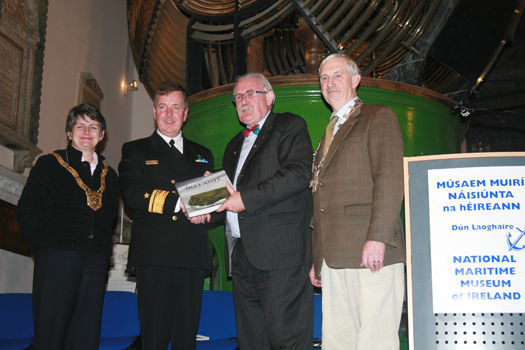
Top people at the launching of the Seascapes book Sailing By are (left to right) Cllr Marie Baker (Cathaoirleach of Dun Laoghaire-Rathdown County Council), Rear Admiral Mark Mellett DSM (Deputy Chief of Staff , Defence Forces), Marcus Connaughton of Seascapes, and Richard McCormick, President of the National Maritime Museum. Admiral Mellett is being presented with the book The Atlantic Coast of Ireland, as he already has his own copy of Sailing By – he wrote the foreword.
His enthusiasm is palpable, and he provided a foreword for the book which speaks from the heart, yet provides a practical and businesslike outlook. In fact, that was the flavour of the evening in the National Maritime Museum, as it was hosted by Richard McCormick, the recently elected President of the National Maritime Museum, and the speakers included the Cathaoirleach of Dun Laoghaire-Rathdown County Council, Cllr. Marie Baker, and Tom McGuire, head of RTE Radio 1, who knows better than anyone just what has been needed to keep Seascapes on the airwaves for 25 years.
Most of all it has of course been the sheer dogged determination of Tom MacSweeney working on his own as producer and presenter in RTE's Cork studio, followed by his successor Marcus Connaughton, who came in as producer when the Thomas Davis Lectures were added to an already almost impossibly demanding schedule in 2002, and stayed on to become presenter eight years later.
They're two very different people. Tom is so involved and enthusiastic that occasionally his own personality, opinions and attitudes cloud the issue. He's a complex man with many interests, not least of them being a national Vice President of the St Vincent de Paul Society. But as regular visitors to Afloat.ie will know, he continues to broadcast his own maritime programmes through community radio, and he's a much-sought-after speaker on sea matters. Recently, he gave a sold-out talk - How Stands Our Island Nation? - to the Dublin Bay Old Gaffers Association in the Poolbeg Y&BC, and while he had the usual serious message, it was leavened by his sharp wit, with the laugh of the evening being provided by his reading of the pained official letter from an Irish Lights Manager complaining about the sheer incompetence and slovenly carelessness of Brendan Behan when he was employed as a painter renovating the St John's Point lighthouse in County Down.
That said, it was a telling lesson in the importance or otherwise of maritime affairs in Ireland's national and cultural life in times past, that the story of a noted playwright making a complete hames of painting a lighthouse was something you knew would register more readily with a general audience than anything of more direct nautical interest, and it is an awareness of the need to reach out gently to the general public which sets the tone of Marcus Connaughton's presentation of Seascapes.
He arrived in the job first as producer, and then as producer/presenter, with no personal baggage in maritime matters. His background was in music production and public relations, and a couple of years ago he brought seventeen years of research and writing to a successful conclusion with the defining biography of Rory Gallagher. But gradually he has become absorbed in and intrigued by the world of boats and the sea. As one of the speakers on Monday night put it, one of the most quietly impressive peformances you'll see is Marcus – who is by no means a small man – sidling into the crowd at some maritime gathering, armed with microphone and recorder, ready and willing to give a voice to the voiceless.
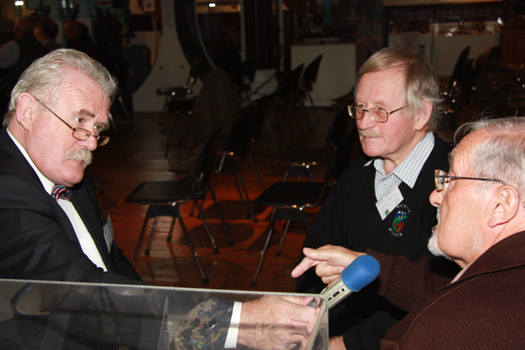
Man at work – Marcus Connaughton records the memories of Alan Martin and Jimmy Carthy of the Dublin Dockworkers Preservation Society
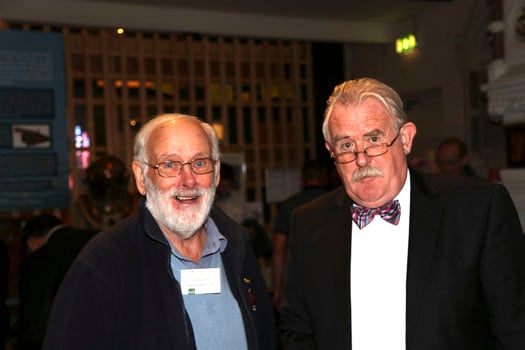
Tim Magennis (left) President of the Dublin Bay Old Gaffers Association, with Marcus Connaughton. Once upon a time, they were work colleagues in the PR Department of Bord Failte

The book launch begins to become a party – Con Murphy of the National YC (left) and Brian Craig of the Royal St George YC getting their copies of Sailing By signed by Marcus Connaughton in the National Maritime Museum. Photo: W M Nixon
The changeover to a new presenter was fairly gradual, but very marked in one thing – he changed the signature tune. When Seascapes started in 1989, they simply borrowed the music which precedes the BBC Shipping Forecast, Ronald Binge's "Sailing By".
"Sailing By" in almost any form is the sound of syrup being poured over sugar lumps, but some folk loved it, so the change to the brisk tone of Simon Mayer's The Reel Thing wasn't universally popular, even if welcomed by those of us trying to cut down on the sucrose.
Yet it's surely an appropriate 25th anniversary sweetener that the published compendium of Seascapes stories is titled Sailing By, and the cover is a fine photo of the renowned pilot cutter Jolie Brise sailing by the Fastnet Rock. It was taken by Brian Carlin of Tralee, who subsequently went on to be the award-winning photographer aboard the Volvo 65 Team Vestas, which unfortunately managed to do some excessive impactive navigation off Mauritius during the Volvo World race last weekend. It was certainly not the photographer's fault, but it heightened the sense of an Irish maritime community worldwide that at Monday night's gathering, Marcus was able to tell us that not only was Brian all right, but that in contacting his father to say so, he requested that the message be passed on to Seascapes as soon as possible.
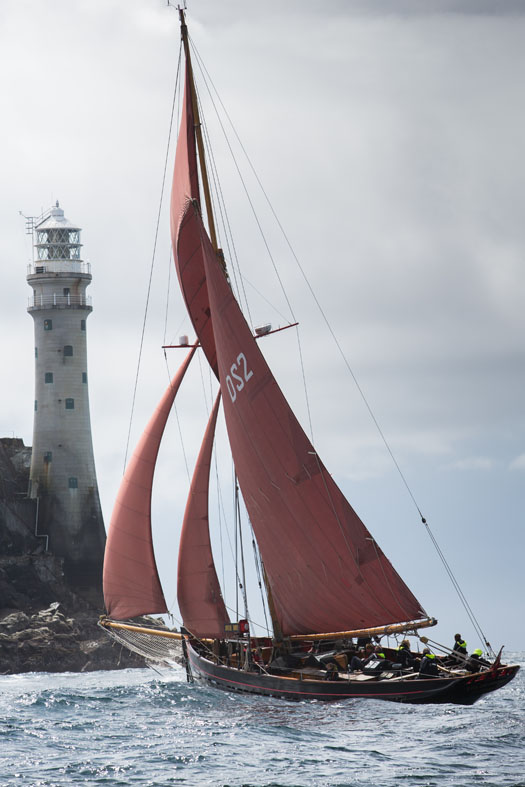
One of award-winning photographer Brian Carlin's studies of Jolie Brise sailing by the Fastnet Rock. Photo: Brian Carlin
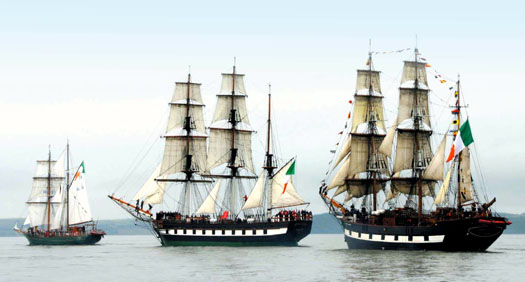
The top moment – it's 2005, and the Seascapes team are on board Asgard II as she leads the Dunbrody of New Ross, and the Jeanie Johnston of Tralee, in the Parade of Sail at the Tall Ships visit to Waterford. Photo: Dave Osborne
As for Marcus's own special recollections of his years with Seascapes, we allowed him six and he ranked them: (1) Being on Asgard II in Waterford with the Tall Ships in 2005, (2) at sea off Hook Head with Martin Colfer amidst enormous schools of lively dolphins, (3) in Galway during both Volvo visits, (4) being far up his beloved Munster Blackwater beyond Ballinatray at the top of the tide, (5) celebrating 25 years of the Killybegs Fishermen's Association at a monster party in the great Donegal port, and (6) being in the renovated National Maritime Museum in Dun Laoghaire when it was re-opened by President Michael D Higgins.
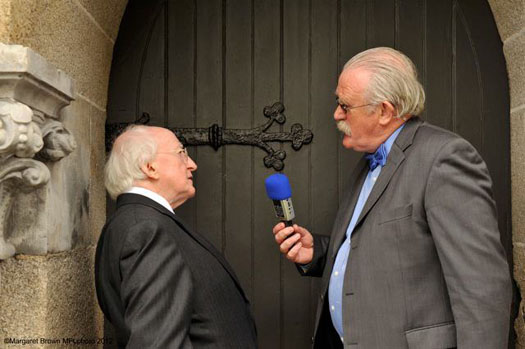
Presidential thoughts of the sea and seafaring in Ireland – Seascapes interviews President Higgins after he has re-opened the restored National Maritime Museum in Dun Laoghaire. Photo: Margaret Brown
Seascapes was of course broadcast as usual last night at 10.30pm, and Marcus Connaughton will be signing copies of Sailing By in Waterstones in Cork this afternoon from 2.0pm to 5.0pm. The first of the six Thomas Davis lectures from 20012 – Paddy Barry's lyrical account of sailing round Ireland – will be broadcast on Friday December 19th, and they'll continue weekly until the final one on February 6th, which is my own item about why most people in Ireland think sailing enthusiasts are so odd. As mentioned at the Glandore Summer School in July, I've changed my mind about some aspects of that, and I'll probably have changed it yet again when Marcus provides me with the space for further thoughts on the matter on Seascapes some time after February 6th.
But meanwhile, happy birthday to Seascapes – you provide a wonderful example of genuine public service broadcasting.
On the Radio: Trailing The Fin Whale
#MarineWildlife - Tonight's Nature on One on RTÉ Radio 1 joins the Irish Whale and Dolphin Group (IWDG) on a quest off Hook Head to find the majestic fin whale.
As TEN reports, Colin Stafford Jones was on board with the IEDG's Pádraig Whooley on a mission to track down the world's second largest animal - not only the biggest example of marine wildlife behind the incredible blue whale.
Their adventure will be broadcast tonight (Sunday 9 June) from 7pm on RTÉ Radio 1, and will be available to listen online afterwards via the Nature on One website HERE.
New TV Series Unveils 'Secret Life of the Shannon'
#OnTV - Sunday 26 May sees the first of a two-part documentary series on The Secret Life of the Shannon on RTÉ One.
The series will take viewers on a journey along the River Shannon with wildlife cameraman and presenter Colin Stafford Johnson, who spent a year living on the river on a barge, camping on its banks and exploring its tributaries in a traditional canoe.
His quest was to film the natural history of the 340km of the Ireland's longest inland waterway as it has never been seen before - and if the above video is anything to go by, he's done an incredible job.
The Secret Life of the Shannon part of the RTÉ Goes Wild month-long celebration of Ireland's wildlife on television, radio and online.
Episode one will be broadcast on Sunday 26 May at 6.30pm on RTÉ One, with the second episode to follow at the same time on Sunday 2 June.
'Fact Finders' Visit Dun Laoghaire RNLI for RTÉ's 'Elev8'
#RNLI - Dun Laoghaire RNLI will feature on RTÉ‘s youth programme Elev8 next week.
A number of the lifeboat station’s volunteer crew took time out on Monday to spend the afternoon filming a segment for the show, which will be broadcast at 4pm next Thursday.
The segment, called 'Fact Finders', follows presenter Sean Regan and 10-year-old Justin Lazarev from Dublin as they go head-to-head to find out as much as they can about the RNLI. They will be brought back to the studio tomorrow and tested on how much they have learned.
Justin and Sean were welcomed to the station by Stephen Wynne, Dun Laoghaire RNLI lifeboat pperations manager, and given a tour around both the inshore and all-weather bases by Billy Scully, Dun Laoghaire RNLI lifeboat education and visits officer and a former member of the crew.
The reporters were also brought on board the all-weather lifeboat which was launched under Coxswain David Branigan with mechanic Rory Bolton and crew members Jack Shanahan, Ronan Adams and Dave Farrell on board.
Farrell, who is also the volunteer lifeboat press officer at the station, said filming with RTÉ’s Elev8 was a great opportunity to showcase the volunteer ethos that exists at Dun Laoghaire and indeed the many other communities around the coast.
“Volunteers come from all walks of life within their communities,” he said. “The crew here in Dun Laoghaire will readily exchange leisure, comfort and sleep for cold, wet and fatigue as is required.”
Last year Dun Laoghaire RNLI brought the highest number of people to safety in Ireland, with 76 individuals rescued by their volunteer lifeboat crews during 46 callouts.
Speaking following Monday’s filming, Justin’s mother Adriana said: “It is so refreshing to see that there are still people out there with a big heart who would risk their own life to save others without looking for a financial gain.
“I was really impressed by the dedication, courage and humanity that you all are sharing. Fair play to you all.”
Elev8 can be seen at 4pm next Thursday 7 February on RTÉ Two.
River Barrow Features in New Series of 'Abhainn'
#OnTheTV - A new series of Abhainn begins this evening on RTÉ One as the Irish-language TV programme explores Ireland's second-longest river, the River Barrow.
Described by the Kilkenny People as one of Ireland's most picturesque rivers, the programme will follow the near 200km journey from Glenbarrow Waterfall in Laois and along the Kilkenny-Carlow border - stopping along the way at such spots as Cushendale Woolen Mills - till it joins with the Nore at New Ross.
Future editions of the series will focus on the Blackwater and the Erne, taking viewers on a visually stunning journey revealing the unique personality of each river and the stories both ancient and new that tell us who we really are.
The new series of Abhainn begins on RTÉ One tonight Monday 28 January at 7.30pm.
Living the Wildlife Visits 'Underwater Ireland'
#DIVING ON TV - The latest episode of RTÉ One's natural history series Living the Wildlife takes a look at the secrets of 'Underwater Ireland'.
Presenter Colin Stafford-Jones goes diving with renowned underwater wildlife photographer Nigel Motyer, who has had photographs published in National Geographic magazine, to find a conger eel in Killary Harbour, Co Mayo.
Killary is Ireland's only fjord, which means that diving is possible all year round. But SCUBA diving is not the only way to access the underwater world - snorkelling is a cheaper and more practical way, as Victor Kutischev of the website Underwater Ireland demonstrates.
"Victor has seen some remarkable things over the last few years," says Stafford-Jones. "The triggerfish he filmed in Kerry, which we see in the show look absolutely extraordinary; it makes me want to throw on a mask and snorkel right now."
Stafford-Jones also visits old friend Dave Tilley on Sandymount Strand in Dublin Bay, where he shows how to gather a sustainable lunch from the clean waters of the bay - such as the razor clams regularly found on our beaches.
Catch the programme again tomorrow night (Monday 5 November) at 8.30pm on RTÉ One, or click HERE to view via RTÉ Player (available till 22 November in Ireland only).
Irish Free Diver Pushes The Limits of The Human Body
#DIVING - An Irish free diver has told the Irish Examiner how he plunged the equivalent of a 15-storey building beneath the surface of the Red Sea on a single held breath.
Fergus Callagy's breathtaking feat is a highlight of a radio documentary about his extraordinary pastime, Fire and Water, which is available to listen on the RTÉ Radio 1 website.
The Sligo man - who says he can hold his breath for more than five minutes at a time - also recounts how he stunned experts at Sligo General Hospital by slowing his heart rate to an incredible 25 beats per minute - less than half the normal resting heart rate.
"It has been described as the most relaxing extreme sport," says Callagy of free diving, of which he is a leading light in Ireland. "When I got into [it] I started to admire what the human body can do."
The Irish Examiner has more on the story HERE.
Rambler Alert - TV Programme Recalls Dramatic Rescue
The programme includes first-hand accounts of how the yacht inverted in seconds when her keel fell off: the skill of the Baltimore lifeboat crew in recovering sixteen crew members from the upturned hull: the race against time to find the remaining five crew members: their mental and physical struggle to survive almost three hours in the water: and how computer technology led to their rescue as darkness closed in.
'I was cold, so cold...' Wendy Touton talks publicly for the first time about her Fastnet ordeal in tonight's RTE documentary
It features exclusive interviews with Rambler's owner, George David and with his partner Wendy Touton, who was airlifted to hospital in a critical condition after being rescued.
Viewers will also see, for the first time, dramatic video from the rescue helicopter, as well as footage of the race as it rounded the Fastnet Rock and gripping images of the rescued crew being hauled from the water




























